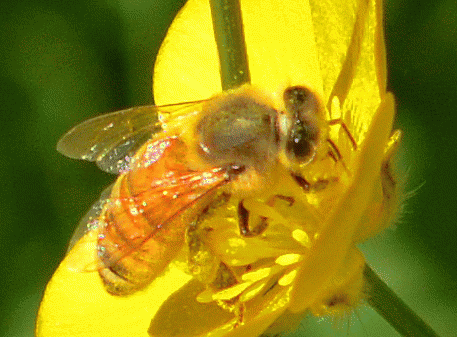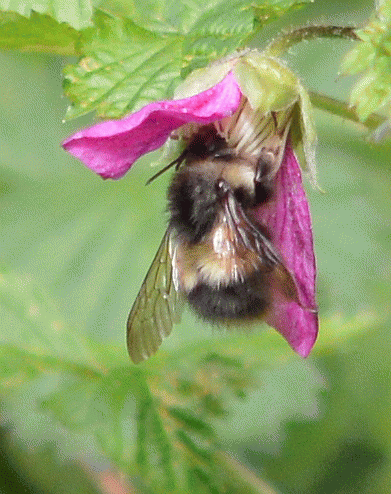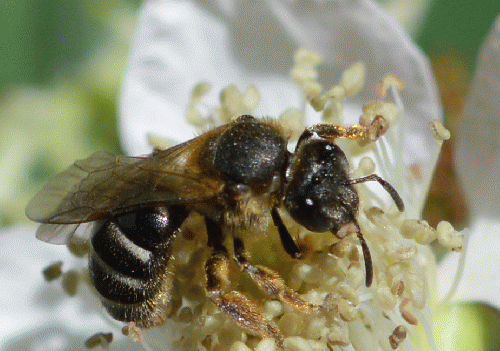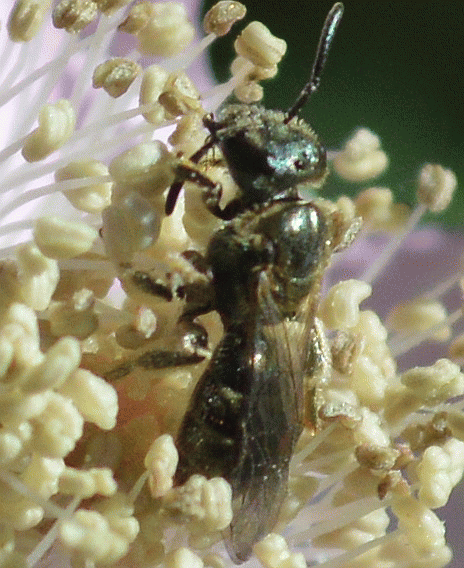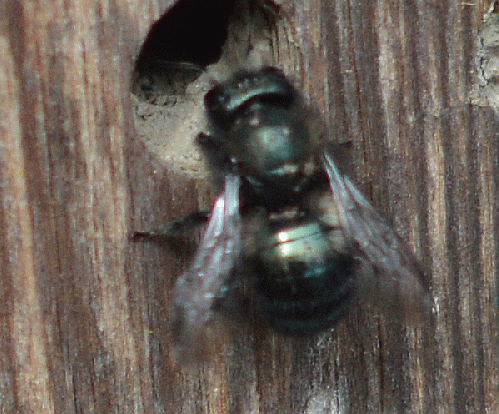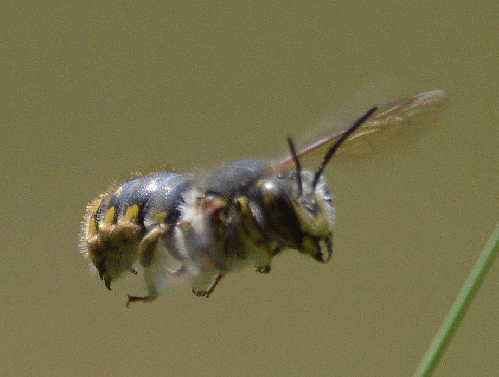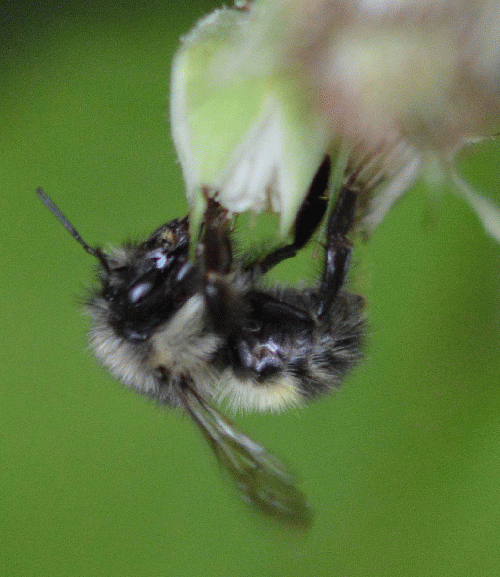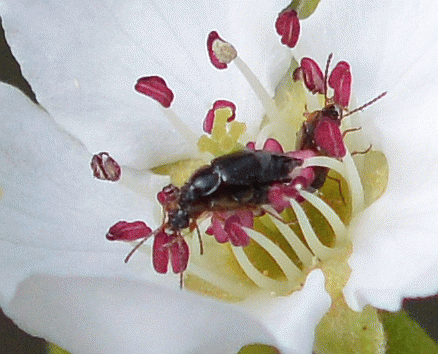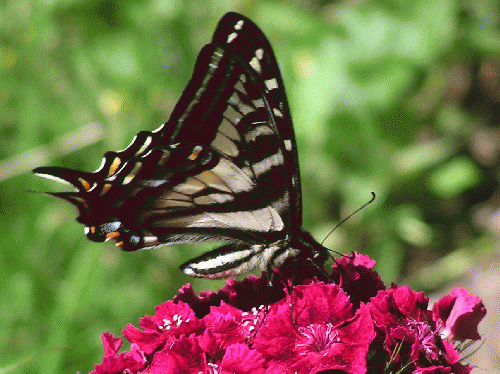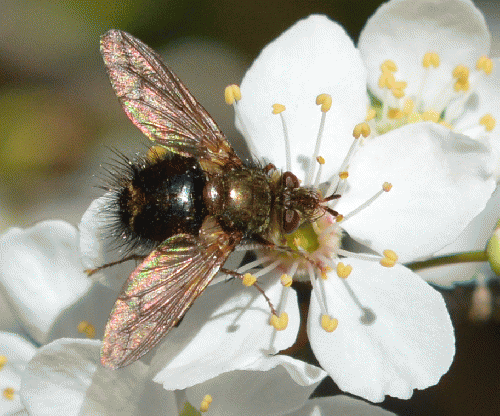| Back OpEd News | |||||||
|
Original Content at https://www.opednews.com/articles/Are-the-Plants-You-are-Pla-by-Chuck-Nafziger-Animals_Bees_Environment_Insecticide-160316-405.html (Note: You can view every article as one long page if you sign up as an Advocate Member, or higher). |
|||||||
March 16, 2016
Are the Plants You are Planting to Help Bees Actually Killing Them?
By Chuck Nafziger
Pesticides are becoming so prevalent that often people do not know they are being used. This is one of the reasons for the decline of honey bees and other pollinators.
::::::::
"Lulled by the soft sell and the hidden persuader, the average citizen is seldom aware of the deadly materials with which he is surrounding himself; indeed, he may not realize he is using them at all." Rachael Carson, "Silent Spring," 1962
While doing research for a talk "Forgotten Pollinators and How to Keep them Around," for which I was a co-presenter at the Alger Community Hall on February 5, 2016, I kept running into pesticide concerns. Many analyses show that the use of pesticides, especially neonicotinides, are killing bees and other pollinators. The further I looked into this, the bigger and more obvious the problem became. We essentially are waging a "War on Bees." The war is on all insects and, as with all such -- like the War on Terror or the War on Poverty -- there are more unintended consequences than intended ones. Unless the stated goal is to attempt to sate the insatiable war profiteers, the goal is never accomplished.
In this case, bees and all other pollinators get nailed. There is also a lot of confusion because when the average person thinks of pollinators s/he thinks only of honey bees. There are many other insect pollinators including native bees, many types of flies, some beetles, many butterflies and moths, and many wasps. In the bee category alone, there are dozens of species involved, most with very different lifestyles from honey bees. All of these insects are being affected by the omnipresent use of pesticides, as are the bat and bird pollinators that are just a little higher up the food chain.
Honey bees, although non-native, give us honey, are easily domesticated so they can be shipped to agricultural fields on demand, and exist in colonies of tens of thousands of individuals. As a result, they have become the poster child for pollinators. According to the US Department of Agriculture (USDA), honeybees have huge health problems:
"Honey bees, which are a critical link in U.S. agriculture, have been under serious pressure from a mystery problem: Colony Collapse Disorder (CCD), which is syndrome [sic] defined as a dead colony with no adult bees or dead bee bodies but with a live queen and usually honey and immature bees still present. No scientific cause for CCD has been proven.
"But CCD is far from the only risk to the health of honey bees and the economic stability of commercial beekeeping and pollination operations in the United States. Since the 1980s, honey bees and beekeepers have had to deal with a host of new pathogens from deformed wing virus to nosema fungi, new parasites such as Varroa mites, pests like small hive beetles, nutrition problems from lack of diversity or availability in pollen and nectar sources, and possible sublethal effects of pesticides. These problems, many of which honey bees might be able to survive if each were the only one, are often hitting in a wide variety of combinations, and weakening and killing honey bee colonies. CCD may even be a result of a combination of two or more of these factors and not necessarily the same factors in the same order in every instance." [1]
Some researchers even include electromagnetic smog from wi-fi and cell phone systems as a possible factor in CCD.
Unfortunately, the way honey bees are transported, often thousands of miles, to work pollinating fields along with other honey bee colonies, many of these diseases and parasites are spread and become universal. Some of these problems even spread from infected honey bees to native bumble bees, as well as other bees and insects. The problems with honey bees are so great, some question whether they will continue to be viable. If they do go down, will the other pollinators go with them?
One phrase from the USDA jumps out at me: "...and possible sublethal effects of pesticides." It is common sense that the sublethal effects of pesticides make the bees weaker and more susceptible to the fungi, mites and viruses. It is tragic that the USDA calls this a "possible" problem: It is an obvious, major problem and, if the USDA were not profoundly influenced by the lobbying efforts of the chemical manufacturers [2], they would state that in capital letters! It makes me wonder if the honest bureaucrat who insisted on including pesticides as a problem jeopardized his/her employment potential, and if the one who inserted the nonsensical fluff word "possible" is on the fast track for promotion.
Two of my references, "Forgotten Pollinators" by Stephen Buchmann and Gary Paul Nabhan [3], and "Pollinator Conservation Handbook" by the Xerces Society [4], repeatedly mentioned pesticide problems. I seldom find a week when the problems of neonicotinoids killing bees is not in some news article or another.
Last fall, I ordered a big batch of bulbs, planning to improve pollinator habitat and assure that I had blooming flowers all spring, summer and fall. An hour or so after putting in an on-line order, I had a realization that I should check to see if the bulbs I had ordered would be pesticide free. I called the company and spoke to a very knowledgeable service rep. She said the bulbs came from Holland and she could not guarantee they were pesticide free. I mentioned that Holland had banned neonicotinoids a couple of years ago. She agreed, but said neonicotinoids were systemic and remained in the soil for many years. I told her I was using the flowers to attract pollinators and she willingly canceled my order.
I then called another very large bulb supplier. Their sales rep did not understand my concerns and left to speak to a supervisor. When she returned, she assured me that "Our bulbs are treated for pest resistance," so I knew not to order them. After that, I Googled "organic bulbs" and successfully ordered bulbs from Peaceful Valley Farm and Garden Supply (www.groworganic.com).
An article "The Perfect Crime, What's Killing all the Bees" [5] offers an insightful quote:
"Many of the plants available for sale at Home Depot, Lowes, or other garden supply stores have been treated with neonicotinoids. Lawn fertilizers also frequently contain weed-killing substances that persist in the soil for years. While bees don't bother with grass, if a homeowner decides to build a garden or plant bee-friendly clover in tainted soil, the bees will be exposed.
"Homeowners are planting flowers in their yards thinking they're helping bees and they're basically planting poison plants," says Erin MacGregor-Forbes, an urban beekeeper in Maine.""
Even this quote from someone interested in protecting bees falls into the honey bee trap. If the subject, "Bees" includes bumble bees, digger bees, miner bees, and the many other ground nesting bees, excluding negative effects on grass and soil becomes a nonsensical minimization of the issue since pesticides in the ground are a huge problem for them. When one includes the other pollinators besides bees this becomes even more of an understatement.
For confirmation, I stopped in both Home Depot and Lowes. The Home Depot manager reported they got their plants from outside suppliers and did not know the treatment history of their plants, however tended to think pesticides were not used unless needed and that plants were not treated by Home Depot. That answer left me with major doubts. The Lowes plant manager was more forthcoming with an answer of "I do not know for sure, but they were probably treated."
I called several of the local plant nurseries in Skagit and Whatcom Counties and received what I thought were surprising results.
First, most do not know if the plants they supply come from seeds that have been treated with neonics (neonicotinoids). Added to that, several of the people I spoke with said that
1. pesticides are expensive so unless they were needed, they probably were not used,
2. pesticides break down so anything used on the seeds would no longer exist in lethal quantities.
3. customers want perfect plants, not plants being attacked by bugs.
I will agree with point 3, but I have serious doubts about the first two. In regard to point 1 about the chances that seeds were treated, Wikipedia states
"As of 2013 neonicotinoids have been used in the U.S. on about 95 percent of corn and canola crops, the majority of cotton, sorghum, and sugar beets and about half of all soybeans. They have been used on the vast majority of fruit and vegetables, including apples, cherries, peaches, oranges, berries, leafy greens, tomatoes, and potatoes, to cereal grains, rice, nuts, and wine grapes.[14] Imidacloprid is possibly the most widely used insecticide, both within the neonicotinoids and in the worldwide market." [6]
This leads to an inference that neonics are very often used in a preemptive way. The information about them being used on apples, cherries, peaches, oranges and berries leads directly to the realization that we are foolishly sickening or killing the pollinators necessary for the very existence of the fruits that are being doused with insecticides.
Regarding point 2 concerning how long the toxins are lethal, the same Wikipedia entry states:
"Most neonicotinoids are water-soluble and break down slowly in the environment, so they can be taken up by the plant and provide protection from insects as the plant grows.[citation needed] Independent studies show that the photodegradation half-life time of most neonicotinoids is around 34 days when exposed to sunlight. However, it might take up to 1,386 days (3.8 years) for these compounds to degrade in the absence of sunlight and micro-organism activity. Some researchers are concerned that neonicotinoids applied agriculturally might accumulate in aquifers."
Many other references talk at length about the longevity of neonics and their decomposition products. It is also necessary to consider the issue of lethality. Many of the studies base longevity on the time for which the pesticide will be lethal to a given percentage of exposed insects. These numbers are stated using terms like LD50, which usually means lethal dose to 50 percent of exposed animals when in contact for a specified test duration. [7] These lethality numbers do not take into consideration how sick the remaining 50% become, just that they did not die during the test. And the longevity of the tests usually do not expose chronic, low level, poisoning. Another article expanding on this, "Beekeeper-Who-Sounded-Alarm-on-Colony-Collapse-Disorder-Loses-90-of-His-Hives" states:
"These poisons can stay in our soilfor up to 18 years and their metabolites are even more dangerous than the parent compounds. They kill worms and other microorganisms and compromise our soil's overall health." [8]
The pesticide manufacturers play on confusion and quickly point out the other things killing bees, like varroa mites, viruses, and fungi. As mentioned earlier, these other factors are more lethal to insects that have been poisoned but are not in the 50% of their cohort who died outright. These pollinators would much more likely be successful fighting off these assaults if they were healthy. They would also be more likely to breed enough generations to develop a resistance to them. The way things are, insects in general are in big trouble and the pesticide problem is much greater than most people realize.
My 97-year-old aunt in Illinois recently observed that there are not as many birds as there used to be around her house and garden. The above referenced Wikipedia paragraph about the near universal use of neonics in ubiquitous corn and soybeans grown in the midwest tells me that she lives in a grossly poisoned area of the US.
Clair Thompson writes in Grist,
"The chemical industry alleges that bees don't like to collect corn pollen, but new research shows that not only do bees indeed forage in corn, but they also have multiple other routes of exposure to neonics.
"The Purdue University study, published in the journal PLoS ONE, found high levels of clothianidin in planter exhaust spewed during the spring sowing of treated maize seed. It also found neonics in the soil of unplanted fields nearby those planted with Bt corn, on dandelions growing near those fields, in dead bees found near hive entrances, and in pollen stored in the hives." [9]
I am frankly surprised that there are birds still living at all in such a location.
As can be seen, it becomes very difficult to know if the plants one buys for providing beautiful flowers, and in turn pollen and nectar for pollinators, have been treated with pesticides either as seeds or during greenhouse nurturing. Most plant sellers do not know the history and their desire to sell pretty plants makes them reluctant to find out. They would rather not know because the customer wants both beautiful plants and healthy bees, so it is easier to stop the discussion at beautiful plants, avoid the part about bees, and make the sale. I have come to the conclusion that if the plant is not certified organic, or the buyer does not know the history, it is most likely toxic.
For toxin-free plants, I trust local seed swaps and most of my neighbors, and store-bought plants labeled "organic" or "neonic free." The only nursery in my area that came up pretty clean was Cloud Mountain. I did not check all the plant nurseries: There may be others who are careful about sourcing toxin-free plants so it is important to do your own checking. When you do so, make sure to trace products all the way back to the seed. A plant catalog I have from Prairie Moon Nursery says it clearly in a section it entitles "Just Say No to Neonicotinoids:"
Neonicotinoids (neo-nih-CAH-tin-oids) are sysemic chemicals which are absorbed into the plant's vascular system, leaving the entire plant toxic to both target and ton-target insects. This class of insecticides is particularly harmful to bees. Prairie Moon has never used these insecticides and is proudly neonicotinoid FREE. We have also confirmed that our partnering seed and plant producers do not use this persistent and harmful class of chemicals." [10]
The last sentence is important and it is the one lacking in most of the discussions I had with plant and seed suppliers. It has become more important to sell perfect flowers or blemish-free fruit than to protect pollinators. We have to understand that this dichotomy has a clearly unsustainable future and change it with our voices and our pocketbooks.
The problem of pollinator poisoning is much bigger than just honey bees. Forgotten pollinators include bumblebees, native ground and wood nesting bees, wasps, butterflies, moths, many species of flies and beetles, hummingbirds, and in some parts of the country, even bats. On top of this are all the creatures higher on the food chain that depend on the pollinators -- including humans. I will end with a quote from "Colony Collapse Disorder Is Not What You Think" by Willy Blackmore:
"If saving the bees means changing what we provide them--more diverse farms, less pesticide use, smaller-scale agriculture existing alongside wild habitats--we may be doing more than warding off the silent spring. We may be saving ourselves." [11]
1. USDA, Honey Bee Health and Colony Collapse Disorder, www.ars.usda.gov/news/docs.htm?docid=15572
2. Mother Jones, 90% of Corn is Coated with Bayer's Bee Decimating Pesticide. http://www.motherjones.com/tom-philpott/2012/05/catching-my-reading-ahead-pesticide-industry-confab
3. "Forgotten Pollinators," Stephen Buchmann and Gary Paul Nabhan
4. "Pollinator Conservation Handbook," Xerces Society, Matthew Shepherd and Stephen L. Buchmann
5. click here
6. en.wikipedia.org/wiki/Neonicotinoid
7. en.wikipedia.org/wiki/Median_lethal_dose
9. Grist, "Honeybee problem nearing a 'critical point"By Claire Thompson on 13 Jan 2012
10 .Prairie Moon Nursery, Native Gardener's Companion Spring-Summer 2016
11. click here
Authors Bio:
I deal with the contradiction of being a retired mechanical engineer and a Luddite at the same time. I have lost faith in our government: it is totally controlled by the corporate monster that is gobbling up the world. It uses mechanical engineers to make weapons or machinery to put people out of work while obscenely stripping natural resources. So long as science, medicine, education, justice, legislative and media are bought and controlled by psychopathic oligarchs, Big Brother will guide tech to rule, steal and murder. CO2 climate change is just another boogieman/woman that will be used to cull and control us while making a joke of the word 'sustainable.'
Consequently, I live in a rural area and am learning to grow my own food. This has brought me in closer contact with Nature, the real world, and I have never felt more spirituality. The country and the world can continue on its path to hell, and I will still find peace.
